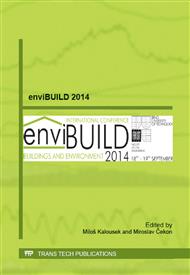[1]
Z. Peřina, B. Plšek, M. Wolfová, Verification of Range of Chemical Grouting of Masonry by Non-Destructive Method Using Infrared Thermography. Proceedings of the Conference on the Rehabilitation and Reconstruction of Buildings CRRB 2013: selected, peer reviewed papers from the conference, November 14-15, 2013, Prague, Czech Republic, Trans Tech Publications, 2014, s. 191-194. 978-3-03835-083-5.
DOI: 10.4028/www.scientific.net/amr.923.191
Google Scholar
[2]
Z. Peřina, M. Halířová, B. Plšek, M. Wolfová, Program RRC/04/2010-02 - Support Of Science And Research In The Moravian-Silesian Region 2010 entitled: Experimental Using Of Nondirect Methods Of Infrared Radiation To Determine The Effective Range Of Injection By Long-term Monitoring Of Structures, Final Report 12/2012 – The Authority of The Moravian-Silesian Region (http: /verejna-sprava. kr-moravskoslezsky. cz/dot_17903. html).
Google Scholar
[3]
M. Halířová, E. Rykalová,. Use of multi-criteria optimization for selection of building materials for reconstruction. In Journal Advanced Materials Research. October 2013, volume 899, p.474 – 477, ISSN: 10226680 ISBN: 978-303835040-8.
DOI: 10.4028/www.scientific.net/amr.899.474
Google Scholar
[4]
ČSN P 73 0610: Hydroizolace staveb - Sanace vlhkého zdiva - Základní ustanovení (Czech National Standard No. 73 0610: Waterproofing of Buildings - Rehabilitation of Damp Masonry - Basic Provisions).
Google Scholar
[5]
R. Fabian, Detekce tepelných mostů termovizí. Materiály pro stavbu, 3/2010, Praha: Business Media CZ, s. r. o., 2010, s. 42-44, ISSN 1213-0311.
Google Scholar
[6]
H. Ševčíková, E. Rykalová, R. Fabian, Comparison of the impact of the ventilation ducts on thermal properties of the exterior walls. In Journal Advanced Materials Research. October 2013, volume 899, p.241.
DOI: 10.4028/www.scientific.net/amr.899.241
Google Scholar
[7]
J. Pašek, Fyzikální principy nekontaktní termografie. In: Poruchy a rekonštrukcie obvodových plášťov a striech. Košice: Technical University of Košice, 2004, s. 51-56. ISBN 80-232-0225-1.
Google Scholar
[8]
J. Pašek, Infračervená termografie jako metoda moderní stavební diagnostiky. In: Materiály pro stavbu. 2007, roč. 13, č. 3, s. 42-46. ISSN 1213-0311.
Google Scholar


